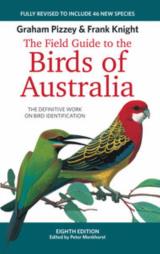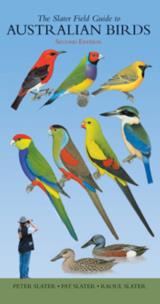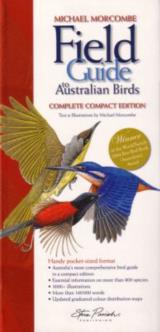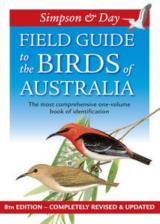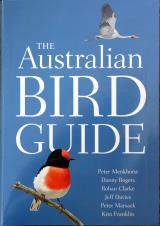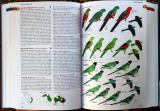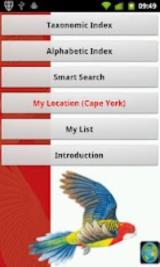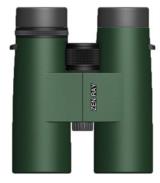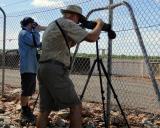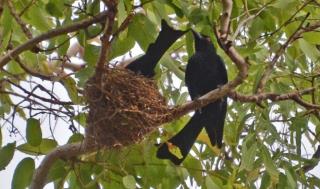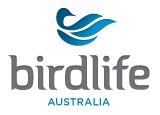Birdwatching Tips
Here are some tips to help you build your bird watching skills.
Field Guide
Up until mid 2017, there were four main field guides covering Australian birds. All of these books were excellent, each has with it's stronger points over others and some birders had a clear preference for one or another. All of them are outdated as many revisions of taxonomies have been made in recent years.
All of these guide books have much more to offer than just pictures and names of individual species. Read the information on habitat, plumage, bird families, bird watching tips, etc. All use taxonomic order, not alphabetic, so you may need to use the index to find a bird.
As you become familiar with the taxonomic order of bird species, you will gain a better understanding of the relationships between different species. Start by learning the difference between a passerine and a non-passerine.
The 2017 'Australian Bird Guide'
Now, there is a new guidebook that updates and supercedes the other four. The ABG or 'Australian Field Guide' by Peter Menkhorst, Danny Rogers, Rohan Clarke and artists Jeff Davies, Peter Marsack and Kim Franklin. Click here for a superb review of this field guide by Chris Watson.
There are two bookstores at Casuarina Shopping Complex, Darwin, and you are most likely able to buy any one of these bird field guides.
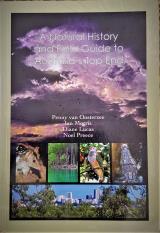
Alternatively, you can use Nokomis mail order book store, they specialize in natural history books for Australia and all over the world.
Two other books that are excellent references for the Top End are 'A Natural History and Field Guide to Australia's Top End' and 'Birds and Animals of Australia's Top End'
Use a Checklist
See if you can download a bird list for your local area, keep it with your guide book and tick off the birds you have seen. Find out about the birds you have not yet seen, this will help you to recognize new species when you do see them.
Click here if you would like to download a free 'Top End Birds Checklist' or enquire about our 'Checklist of Birds of Australia and it's Island Territories'
Smartphone Apps
Michael Morcombe's 'Birds of Australia' was the first phone app for Australian birders. Now we also have available the Pizzey and Knights 'Birds of Australia'. I have both on my phone and, as with the books, could not recommend one over the other, they each have their strong points. The fantastic thing about these apps, in addition to the fact that it they are more convenient to carry in the field than big, heavy books, is the ability to play the birds calls! This is a big help in learning to identify birds by their calls. Ethical birders are very cautious about using the calls as playback in the field. Think of the well being of the bird. The last thing breeding birds need is stress from the threat of intruders in their territory!
Download Morcombe for Android Download Morcombe for iPhone
Download Pizzey for Android Download Pizzey for iPhone
Bird Journal App - 'remember everything'
Having used Bird Journal on my pc for years now, to record daily sighting and compile trip reports, I was delighted to finally get the long awaited app for android.
I usually record each sighting in my notebook. Then, when I get home, enter the sightings, notes and photos into Bird Journal. Now I can enter most of this information in the field using the app on my phone or tablet! Advantages are records are uploaded to the cloud where they are probably safer than on paper. You have a data base of records at your fingertips for reference anytime. Version 5 now includes a 'Reports' function and date range filter.
Click here for more information on Bird Journal.
Binoculars
Size and Power
It is easy to think that the more powerful the binoculars the better they are. I have even had optics staff try to convince me of that. A good configuration for birding is 8x43. This means the magnification is 8x and the objective lens is 43mm. If the magnification is much greater, say 12x, it becomes much harder to hold them still enough to get good views and you have a much narrower field of view. That means that you will have more trouble locating the bird through you binoculars.
The smaller 7x is very good too, with an even greater field of view. Smaller binoculars are available and can be more convenient as they can fit in a pocket and are lighter, but unless they are expensive, top of the range optics, they are not likely to provide satisfying viewing.
Porro vs Roof Prism
Porro prism binoculars have the objective lens (bigger one) offset from the eyepiece lens, dogleg fashion. Roof prism binoculars have the the prism arrangement inline (as with the ED2 7x36). Roof prisms are more compact to use, but more complex to build, so will be more expensive. This could mean that dollar for dollar, you will get better value and performance from a porro. The only way to make an informed decision is to try before you buy. The same pair of binoculars can be perfect for one person but not good for you. It always pays to do your research too.
A binocular harness is more comfortable than a neck strap for most people.
Bird Forum has some in depth discussions on the pros and cons of various binoculars Binocular forum
Need some new binoculars?
We use, import and sell the range of Zen-ray Optics because they provide fantastic viewing quality at a price that is much less than comparable brands. Please click here for more information and prices on the binoculars we have in stock.
Spotting Scopes
Spotting scopes are great for longer distance viewing, such as shore birds and water birds. The scope must be mounted on a tri-pod. The tri-pod should be of good quality and well matched to the scope to ensure a good quality view. Camera adaptors are available, allowing you to swing the camera lens up to the eyepiece for a photo, and then swing it our of the way for normal viewing.
Photography
Bird photography adds a whole new dimension to birding. For some it is the main focus of their birding experience and some keen photographers don't even use binoculars. Alternatively there are point and shoot compact cameras available now that have an amazing capacity to obtain good record shots and even video. I use a Nikon P9000 that has an 83x zoom! I'm very happy with the results I'm getting and it works well as all-rounder with out being too heavy to carry. If you are a keen photographer you may want to check out our Top End Photography Tour
Technique
It is recommended to wear clothing that is of a subdued colour, and move about quietly and calmly, avoiding sudden movements, all this to gain the confidence of birds that are often gaudy, noisy and flitting hyperactively from branch to branch. It's good to wear a hat, not only to shade your head but also to protect your head from being poked by branches and reduce glare around your eyes as you look through your binoculars. I think the hat also helps a little bit to break up the 'scary human' profile.
When you are searching out birds in a wooded area, and birds have the advantage of being able to hide their small bodies behind foliage, be alert for movement and sound. As soon as you see or hear a bird, move your binoculars to your eyes without taking your eyes off the bird.
1. Listen for calls
2. Look for movement and plumage within the foliage
3. Bring binoculars up and focus... slowly and steadily
Approach birds quietly and slowly. Try to get a reasonable view through your binoculars first, when you have done your best to identify the bird, (it might be your only chance) you may decide to move a few steps closer and refocus, doing this several times may bring you much closer to the bird than you thought you could get. This progressive stop, then move closer is also a good way to get a better photo. Remember birds are often very busy little creatures and if they fly off before you have a chance to see them properly, it is not necessarily your observation skills at fault.
If you find a nest, the temptation is to go right in for a close look. First think about the welfare of the bird and the eggs or chicks. Observe from a distance that does not put the nest at risk by spooking the parents or even alerting predators. Please read Birds Australia's Bird Watching Ethics.
Go With a Guide!
Even with all these skills you can miss the sightings you want. Going with a local guide gives you the local knowledge edge plus an extra pair of skilled eyes and ears! If you are visiting Darwin and the Top End, please peruse our itineraries ranging from day trips to our very popular 9 day "Best of Top End Birding'. Be sure to check out our specials!
Please click here to visit our Birdwatching Basics page.
